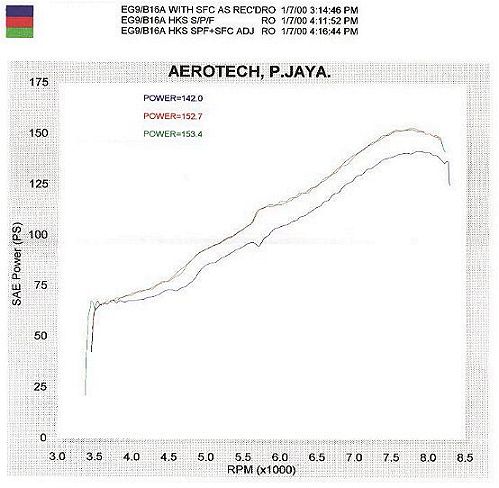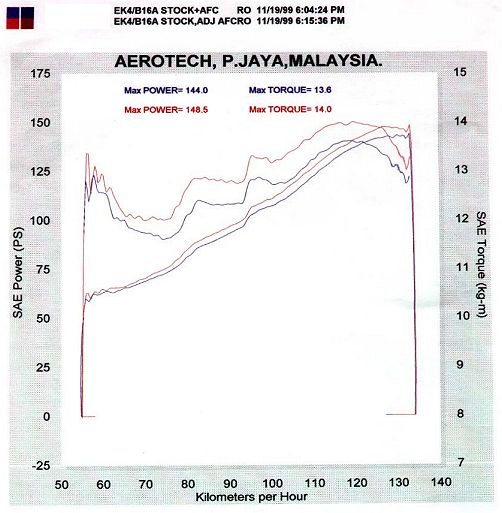
The B16A has already established itself as one of Honda's classic engines. The first VTEC engine to be produced by Honda, B16As have powered both Civics and Integras, and is really the engine responsible for establishing VTEC Hondas as cars with serious performance.
In my last Beyond Stock article, I looked at the power of a nearly stock automatic B16A, used on an EK4. That has allowed us to establish that a stock automatic B16A will dyno at around 110ps at the wheels. Continuing on that article, here I will be looking at manual B16As and to establish how much they will dyno at the wheels in stock form.
Befitting its pioneer status, B16A have undergone an extended development cycle by Honda. The very first VTEC engine, the 1st generation B16A in Japan was spec'ed for 160ps at 7600rpm, with max torque of 15.5 kgm at 7000rpm. Introduced in the DA6/DA8 Integra XSi & RSi in mid-1989, it was subsequently migrated to the EF8/EF9 CRX & Civic SiR towards the end of that year.
These early B16As despite being lower powered than later versions nevertheless have many desirable advantages. The most significant of these is the fact that they come with a built-in oil-cooler. The oil-filter adapter for these early B16As are specially designed to allow engine oil to pass heat to the engine coolant. DA6/DA8 and EF8/EF9 radiators are also bigger while the brake master vacumn pump is rated at 260Nm.
In 1991, Honda introduced the 2nd generation B16A, again in the DA6/DA8 Integra XSi and RSi. The cars themselves also received a very mild face-lift. The Civic and CRX only received this B16A during the EF to EG model change in September 1991. The most significant change done to the 2nd generation B16A is the 10ps increase. B16A now generates 170ps at 7800rpm and a max torque of 16.0kgm at 7300rpm. Red-line has been increased from 8000rpm to 8200rpm.
However, the 2G B16As no longer come with oil-coolers while for the EG Civic/CRX, the radiators and the brake master vacumn pump are also smaller. Nevertheless, the 10ps increase in power, due mainly to a wilder cam-shaft profile and slightly higher compression pistons were ultimately found more desirable by most enthusiasts.
Although the B16A continued to be used when the Civic changed from EG to EK in September 1995, the engine basically remained the same. Max power remained at 170ps with max torque at 16.0 kgm.
Having extensive experience with Dynojet sessions, I remain convinced that it is the most accurate and effective way to ascertain the power of a car. As explained elsewhere in TOVA, Dynojets measures power at the wheels, ie actual power available to drive the car, after all losses incurred from the transmission and ancilliaries like power-steering pump, etc. The last article looked at an automatic B16A which incurs losses as high as 30% to power. For manual transmissions however, the losses are very much more modest. Honda's manual transmission incurs typically 12 - 13% power losses. So coupled with the ancilliary losses, a manual B16A will see only around 15% loss from power at the engine to power at the wheels.
For the 1st generation B16As then, the 15% loss will work out to approximately 136ps at the wheels. While for the 2nd generation B16As, 170ps will work out to around 144ps at the wheels. These are the theoretical value that we would expect to see when stock manual B16As are dyno'ed in a Dynojet facility.

We first look at the dyno'ed power of the 1st generation manual B16A. I do not have a dyno-graph of a stock example but fortunately export B16As are basically the same specifications. As discussed above, a manual 1st generation B16A is spec'ed for 160ps max power which should translate to around 136ps at the wheels.
The real-life correlation to this would be the dyno chart that was supplied by Zacka Chan, of his Australian EK4 Civic VTi-R which uses the export version 160ps B16A engine. This chart has already been examined in its own Beyond Stock article, actually the first article in TOVA's Civic series. As that chart shows, with only a K&N direct drop-in filter, Zacka's Civic dyno'ed at 134ps at the wheels. This corresponds extremely well with the calculated 136ps at the wheels.
Therefore, our reference point for the dyno'ed power at the wheels from a stock 1st generation manual B16A can be very accurately pegged at 136ps.
I have two dyno-charts of the 2nd generation B16A (sometimes called the 170ps B16A). Both are again fortunately of an almost totally stock manual example. Again as discussed above, based on 170ps a manual stock 2G B16A would be expected to dyno at 144ps on the Dynojet.

The first example I have is William's EG9. This JDM unit was purchased as a 4 year old used-import in very good condition by William who confides that TOVA's coverage of the B16A was what prompted him to buy one !! William's dyno run came about because he had a Field SFC unit and after installing into his EG9, had wanted a dyno-session to properly tune it. When he arrived, his EG9 was completely stock except for the SFC unit which was set on 'by-pass'. The first order of business was to perform a base-line dyno. After that, William decided to change his filter system to the HKS Super Power Flow system. As described, this replaces the entire air-filter box with a suitably designed HKS foam-based 'mushroom' air-filter system.

William's dyno chart is shown on the left. The base-line stock dyno came out to 142ps at the wheels, again almost perfectly spot-on the calculated value. The fact that the original stock filter element was very dirty probably also caused some loss in dyno'ed power. Therefore, again we can establish that a stock manual 2G B16A will dyno at around 144ps at the wheels.
The effect of the HKS Super-Power-Flow system was to be honest quite a bit more than expected from a simple air-filter upgrade. Power at the wheels jumped to a huge 153ps at the wheels with the HKS filter, an increase of almost 11ps ! This translates to 180ps at the engine which indicates that William had the unbelievably good fortune of getting an extremely good conditioned engine. Work on setting the Field SFC unit continued. However, probably because the engine is already extremely well tuned, extensive work on the SFC did not yield any increase in power. William's dyno tuning session finally ended with an incredible 153ps at the wheels from his mostly stock 2G manual B16A.
My next example is Johnson's EK4. This JDM unit was purchased as a 2 year old used-import in almost prestine condition. Immediately after getting the car, Johnson sent it for an extended service, making sure the car is in very good state of health. Because the air-filter element was dirty, Johnson decided to replace it during the service. However, instead of the noisier open-element filters, he opted for a drop-in replacement, a Monster air-filter element to fits directly into the stock air-box. The main advantage of the Monster element was that it was a freer-flowing unit as compared to the stock element.

Because his friends had good results with eliminating the catalytic converter, Johnson too decided to replace his with a custom fabricated straight-pipe. Replacement of the cat is a heavily debated topic. Besides the impact to the environment, many people believes that the cat is an essential component of the engine and so replacing it may impact its performance. Nevertheless, it remains a fact that frequently, replacing the cat do result in some gains in the engine's max power.
Like William, Johnson too had an APEXi AFC air-fuel regulator unit. This unit is similar to the Fields SFC unit. Again, Johnson was eager to properly set the AFC unit via a proper dyno-tuning session.
Johnson's dyno-chart is reproduced, on the right this time. This time, the base-line dyno came out exactly at the calculated 144ps at the wheels ! However, readers should bear in mind that the car, as received, already has the aforementioned Monster filter drop-in as well as a deleted cat.
This time however, tuning of the AFC unit did give good results. Final dyno'ed power after properly setting the AFC gave 148.5ps at the wheels. This translates to 175ps at the engine, a very useful 5ps gain over the stock power. Even more significant is the even distribution of the power gain; increase in power started all the way from around 60kph speed in 3rd gear, which translates to roughly 3,000rpm engine revs, and is sustained with gradually increasing power gains right up to the 8200rpm red-line. This kind of power gains is extremely feelable, the cummulative effects during full-throttle runs from low rpms will lead to a relatively larger gain when VTEC is activated and the red-line eventually reached.
Based on the dyno graphs examined in this article, we can be quite confident in establishing a reference point for dyno'ed power for the B16A engine. For a manual stock B16A,
One final point needs to be made on William's exceptional results on his EG9. In general, one should NOT expect 10ps gains from the simple replacement of an air-filter, no matter what the brand. William's result should be taken at face-value and be recognized that as the exception rather than the rule.
Wong KN
March 2001
© Temple of VTEC Asia